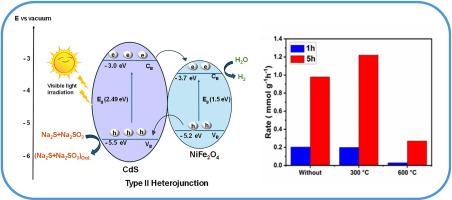促进光催化制氢的NiFe2O4@CdS核壳纳米催化剂的绿色合成
IF 8.3
2区 工程技术
Q1 CHEMISTRY, PHYSICAL
引用次数: 0
摘要
本研究提出了用于增强光催化可持续制氢的NiFe2O4@CdS核壳纳米催化剂的绿色合成和表征。以西瓜皮(WR)、香蕉皮(BP)提取物和八角茴香(SA)提取物为原料制备硫化镉(CdS)纳米粒子。通过扫描电子显微镜(SEM)、能量色散x射线分析(EDX)、透射电子显微镜(TEM)、动态光散射(DLS)、zeta电位测量、x射线衍射(XRD)和紫外可见光谱(UV-Vis)对合成的纳米颗粒进行了表征,研究了它们的结构、形态和光学性质。CdS与NiFe2O4的集成旨在克服传统CdS基光催化剂中常见的载流子重组和光腐蚀等限制。核壳结构表现出优异的析氢光催化性能。光催化制氢分析表明,经过5 h的辐照后,NiFe2O4(300℃)@BP-CdS的平均析氢速率为1220.6 μmol g−1 h−1,超过了制备样品和600℃煅烧样品。活性的增强归因于改进的电荷分离和改进的煅烧过程的光吸收。光电化学评估,包括计时安培法(CA)和电化学阻抗谱(EIS),也验证了与裸CdS相比,NiFe2O4/CdS纳米复合材料的光电流响应增强,电荷转移电阻降低。这些发现强调了绿色合成NiFe2O4@CdS纳米催化剂在推进可持续制氢技术方面的潜力。这些发现对环境保护和经济可持续性都有贡献。本文章由计算机程序翻译,如有差异,请以英文原文为准。

Green synthesis of NiFe2O4@CdS core-shell nanocatalysts for enhancing photocatalytic hydrogen production
This study presents the green synthesis and characterization of NiFe2O4@CdS core-shell nanocatalysts for enhanced photocatalytic sustainable hydrogen production. An eco-friendly approach was adopted to fabricate cadmium sulfide (CdS) nanoparticles using watermelon rind (WR), banana peel (BP) extracts, and nickel ferrite (NiFe2O4) nanoparticles using star anise (SA) extract. The synthesized nanoparticles were characterized through scanning electron microscopy (SEM), Energy dispersive X-ray analysis (EDX), transmission electron microscopy (TEM), dynamic light scattering (DLS), zeta potential measurements, X-ray diffraction (XRD), and UV–Vis spectroscopy to investigate their structural, morphological, and optical properties. The integration of CdS with NiFe2O4 aimed to overcome limitations such as charge carrier recombination and photo corrosion, commonly encountered in conventional CdS-based photocatalysts. The core-shell structure demonstrated superior photocatalytic performance for hydrogen evolution. Photocatalytic hydrogen production analysis showed that NiFe2O4(300 °C)@BP-CdS achieved the most remarkable hydrogen evolution average rate of 1220.6 μmol g−1 h−1 after 5 h of irradiation, surpassing both the as-prepared and 600 °C calcined samples. The enhanced activity is ascribed to improved charge separation and elevated light absorption from the refined calcination procedure. Photoelectrochemical assessments, including chronoamperometry (CA) and electrochemical impedance spectroscopy (EIS), also validated the enhanced photocurrent response and reduced charge transfer resistance of the NiFe2O4/CdS nanocomposite compared to its bare CdS. These findings underscore the potential of green-synthesized NiFe2O4@CdS nanocatalysts in advancing sustainable hydrogen production technologies. The findings contribute to both environmental preservation and economic sustainability.
求助全文
通过发布文献求助,成功后即可免费获取论文全文。
去求助
来源期刊

International Journal of Hydrogen Energy
工程技术-环境科学
CiteScore
13.50
自引率
25.00%
发文量
3502
审稿时长
60 days
期刊介绍:
The objective of the International Journal of Hydrogen Energy is to facilitate the exchange of new ideas, technological advancements, and research findings in the field of Hydrogen Energy among scientists and engineers worldwide. This journal showcases original research, both analytical and experimental, covering various aspects of Hydrogen Energy. These include production, storage, transmission, utilization, enabling technologies, environmental impact, economic considerations, and global perspectives on hydrogen and its carriers such as NH3, CH4, alcohols, etc.
The utilization aspect encompasses various methods such as thermochemical (combustion), photochemical, electrochemical (fuel cells), and nuclear conversion of hydrogen, hydrogen isotopes, and hydrogen carriers into thermal, mechanical, and electrical energies. The applications of these energies can be found in transportation (including aerospace), industrial, commercial, and residential sectors.
 求助内容:
求助内容: 应助结果提醒方式:
应助结果提醒方式:


